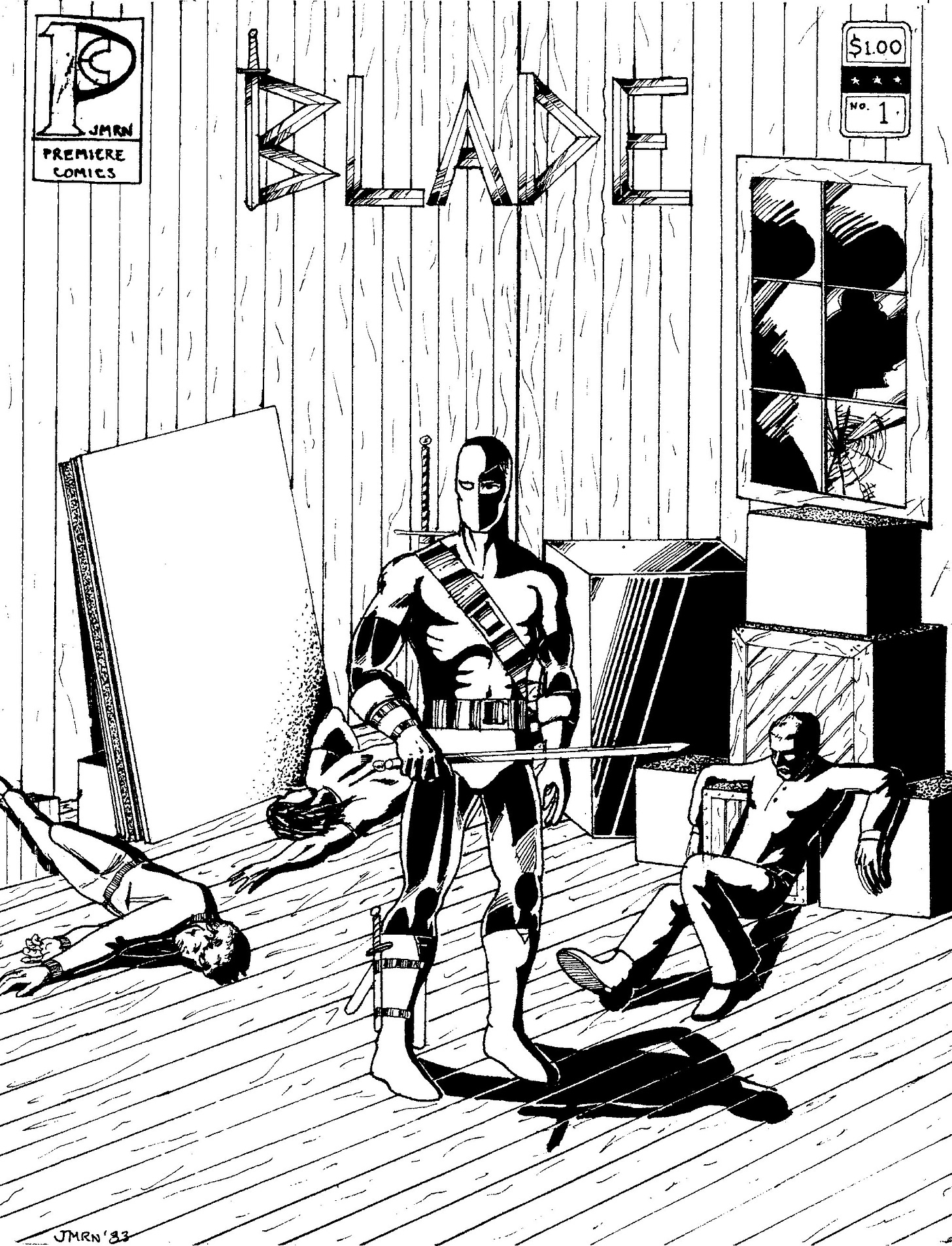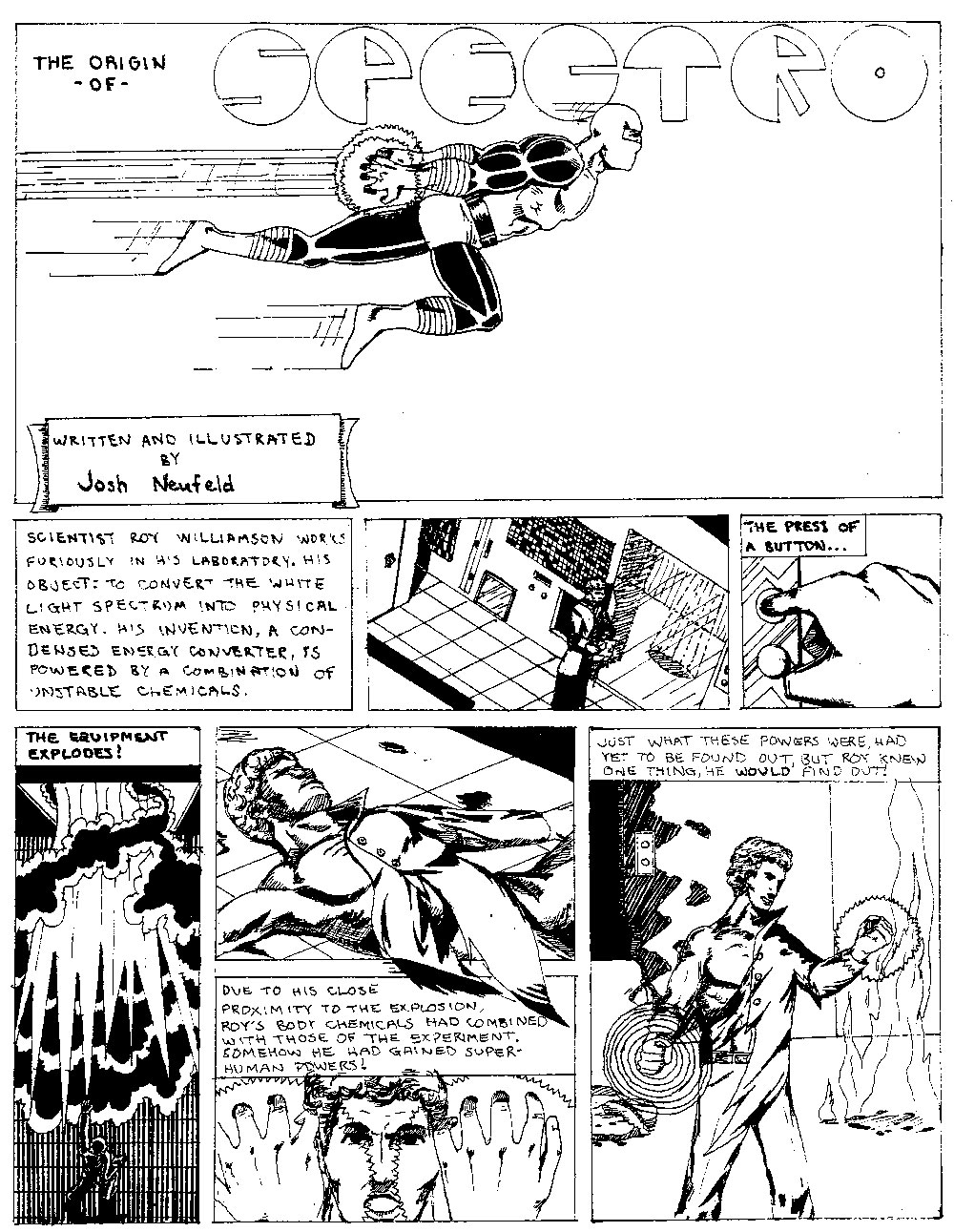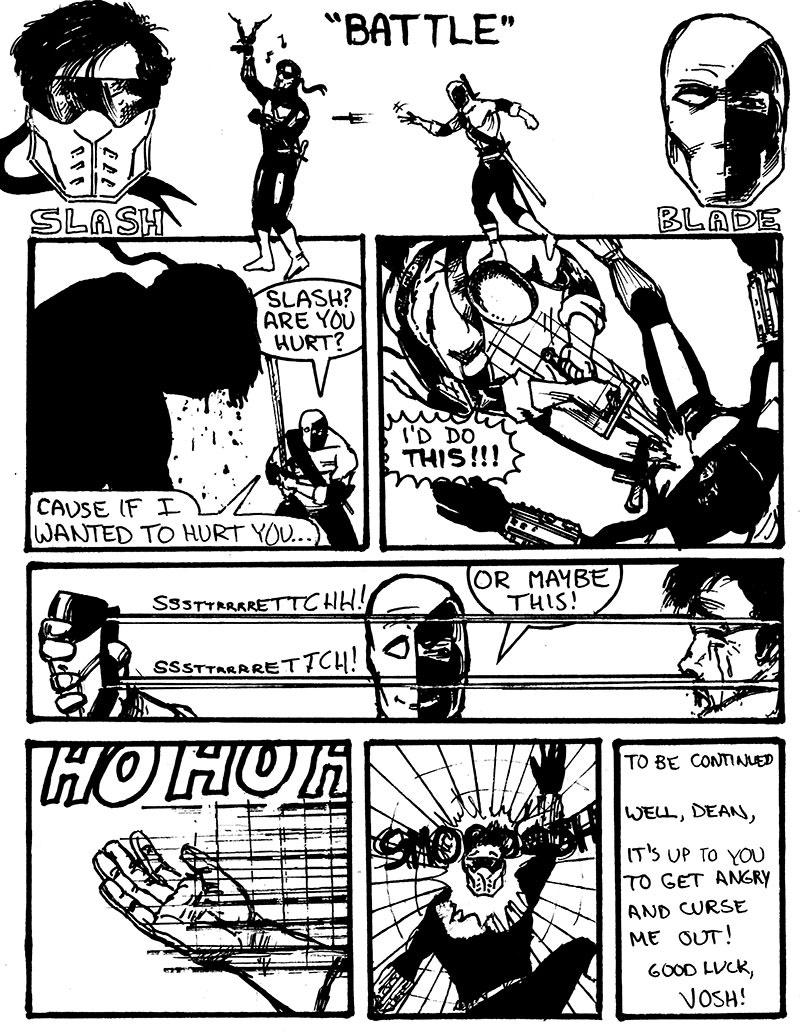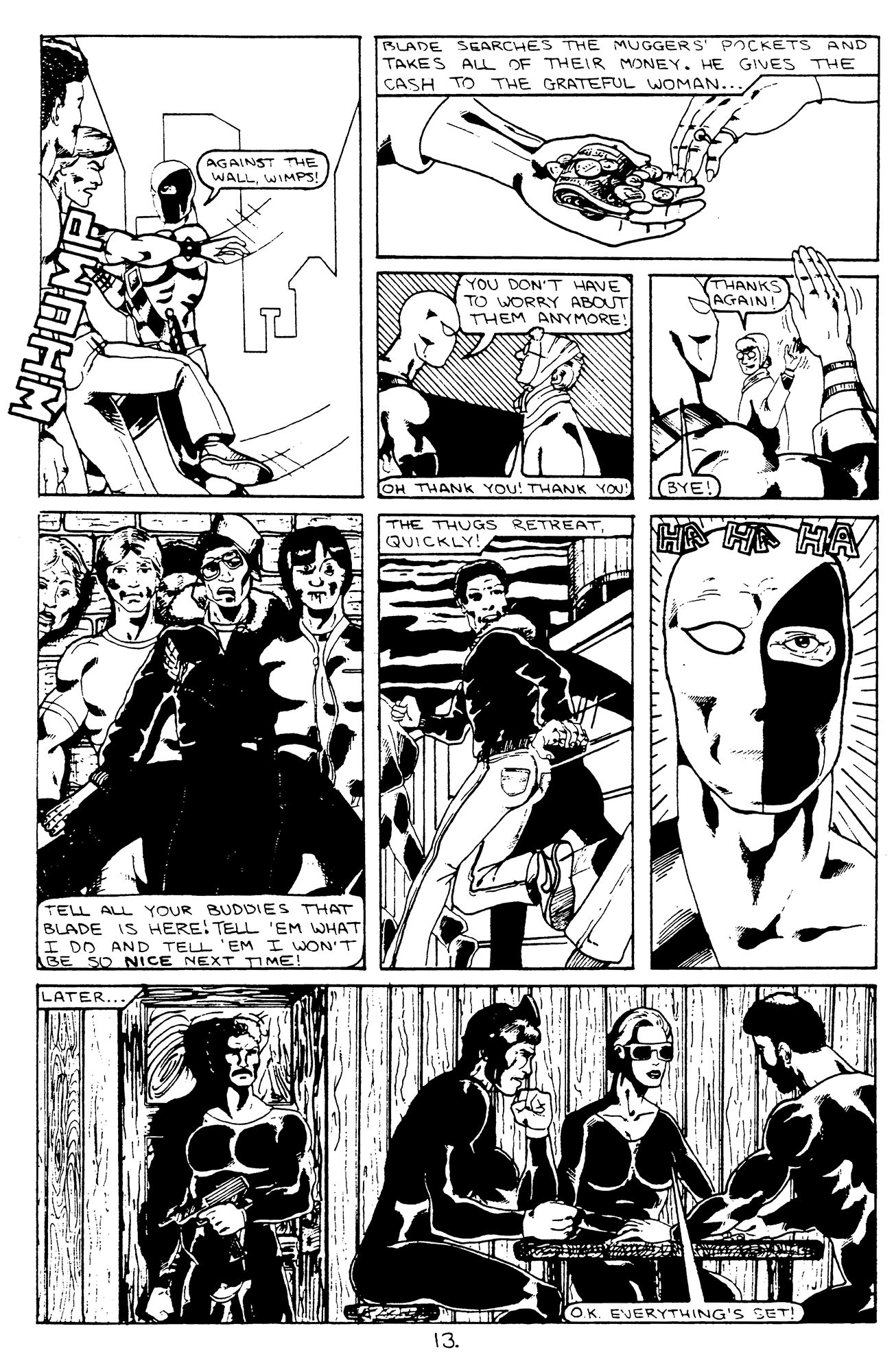Proto-Josh Neufeld
To Superhero or Not To Superhero?
Josh--
It's been nearly 40 years since you created and then abandoned a few superheroes in Music & Art High School where we first met in the early 1980s. I was part of a small comix collective called Paradox Productions that featured me, Mike Hueston, Eric Waldman, Sean Smith, and our favorite inker, Todd Dixon.
JOSH NEUFELD: Yes, by the time I joined up it was halfway through freshman year, and you guys had already established your group.
DEAN HASPIEL: You got wind of our crew and kinda auditioned to join Paradox which was “publishing” (xeroxing, folding and hand-stapling) comic books the likes of Mike Hueston's TEMPEST, and THE NIGHT RAIDERS, Sean Smith's JOT THE FLY, Eric Waldman's QUASAR, ROGUE STAR, and VANGUARD.
JN: If I’m not mistaken, you, Mike, Eric, and Sean had all gone to middle school together, and had made comics back then too, so I don’t think I ever saw some of those projects were mentioned — like Mike’s TEMPEST and Sean’s JOT THE FLY. (I mean, Sean didn’t even go to Music & Art, so I don’t think I ever saw any of his comics!)
DH: That's right! Sean went to Stuyvesant high school but he sometimes hung out with us after school.
JN: Also, don’t forget some other schoolmates like Phil Dejean, who was doing a barbarian comic called ASTERIX, which was no relation to Goscinny & Uderzo’s Asterix the Gaul, which I don’t think most Americans had ever heard of (but I had because my mom bought me European comics like TINTIN and ASTERIX whenever she traveled out of the country pursuing her own art career). And there was Delmo Walters Jr. too, who drew very technical but kinda stiff superhero comics, which were augmented by Todd’s tight, Terry Austin-style inks.
There were other assorted hangers-on as well, but I think we just named the ones who were most committed to making comics all through high school.
DH: I penciled some pages of VANGUARD and QUASAR until I got into a big knock-down drag out fight with Eric because he inked funny noses and mustaches on all my faces for no good reason and it got us suspended from school for three days.
JN: I was in the cafeteria, peacefully eating my school breakfast, when the fight broke out! I knew you guys were always playing pranks on each other and insulting each other mercilessly, so I was shocked when all of a sudden you were grappling and flinging each other around the cafeteria! I think one of you even landed on a table and it toppled over?
The funny thing was I think you guys had made up and were buddies again even before you got suspended.
DH: We did! (hah)
JN: Talking about that fracas, do you remember the next year, when Eric “fired” me as inker on QUASAR, so I drew an illo of Quasar impaled on a giant spear and the words QUASAR MUST DIE! and taped up photocopies of the drawing all through the school? That was fun! I didn’t sign the drawing and I tried to use a different “style," but Eric saw right through the ruse. He confronted me in the lunch room one day, slapping down one of the drawings on the table and saying, “Hi, Anonymous,” or something like that. I feigned innocence, and nothing ever came of it — no fights or suspensions. And we went also went right back to being friends.
Good times.
DH: Indeed. And I was producing my own comic, NIGHTSTALKER, which was about a tiny ninja with a staff.
JN: Nightstalker was so cute! What was his catchphrase? “Ingy Wamba!?"
DH: Yup! I also invented a short-lived character called VAPOR which was a cross between Aquaman and The Green Lantern.
JN: I’m sorry to say I have no memory of VAPOR! Did you make a full comic of him?
DH: I think I wrote and drew 5-pages of Vapor and didn't know what to do with it. But then you brought SPECTRO to the table, a superhero with light powers, and hardly did anything with him.
JN: Yes, Spectro existed for all of one page: his origin story. Todd Dixon inked the first panel which looked pretty good, but the rest of it is a bunch of messy ink lines. I can see why Eric fired me!
DH: And, instead of Spectro, you quickly invented a vigilante called BLADE, inspired by DC Comics' Deathstroke (from Marv Wolfman and George Perez's groundbreaking TEEN TITANS run).
JN: Hey, you totally busted me for ripping off Deathstroke the Terminator! Guilty as charged — though Blade is more of a good-guy whereas Deathstroke was definitely a baddie. (By the way, was I the only one who noticed that Deathstroke’s costume was incredibly similar to Marvel’s The Taskmaster — another villain designed by Pérez?)
DH: Possibly in response to BLADE, I created another character called SLASH, who's costume design (a cross between Batman and Boba Fett) would later serve as THE VERDICT, a comic book series I co-created with writer Martin Powell, published by Eternity Comics and Caliber Press.
JN: When it came to BLADE, I stuck with that character all through high school. The first issue, which I did in the spring of sophomore year, was 16 pages long (and sold for $1). Todd inked all the figures and I did the backgrounds. I plotted the story with the aid of my psychotherapist at the time, if you can believe that!)
Issue #2 of BLADE was produced in the spring of junior year — also with the help of my therapist and Todd. I remember I switched from drawing on letter size copy paper to tabloid Bristol board in the middle of the story, and I was really intimidated by the new size (and the expense of the paper). I drew a scene in issue #2 where Blade beats up a gang of teens whose facial features were all based on us: you, me, Mike, and Eric! BLADE #2 was also 16 pages and even had a letters page!
BLADE #3 was started senior year of high school, but even though I worked on it sporadically right through until I started college, I never finished it. I actually had a social life senior year! I only did 10 pages before I gave up on it.
DH: I think I originally created SLASH to fight your character BLADE. And we enjoyed many silly and downright blasphemous call and response comics that we can hardly publish in today's cultural climate ~ a symptom of our rebellious adolescence, for sure.
JN: Yes: “blasphemous” sums it up! The whole call-and-response comics jam was your idea from the get-go. You started it when I went to college in Ohio and you were hanging back in NYC. You sent me a one-pager with the two guys fighting and then challenged me to continue the story. All through the U.S. mail. My college buddies were fascinated by this epistolary comic we were making, and would always gather around my desk to see the latest installment when it arrived in the mail.
DH: Somewhere around then, I believe you created a character called THE OCELOT, and then you co-created and penciled (and I inked) a superhero duo called STARS & STRIPES with writer Fred Schiller that appeared in the back pages of The Verdict. I don't believe your story ran more than two issues but I don't remember.
JN: STARS & STRIPES actually came first. I met the writer, Frederick J. Schiller, through The Chain, the same APA (amateur press association) that you met Martin Powell through. (I think I got connected to The Chain because of a letter I had printed in TEEN TITANS?). Anyway, I was looking for a writer and he was looking for an artist, so that’s how it happened. I penciled and dialogued STARS & STRIPES during my sophomore year of college at Oberlin. And you inked it!! I have to admit that at that time I wasn’t thrilled with your inks because even though you improved the art on a technical (craft) level, I felt in the end it looked more like your art than mine. But I couldn’t complain because thanks to you I got professionally published for the first time!!
Talking about STARS & STRIPES, your VERDICT collaborator Martin Powell actually wrote a script for the next installment, but for some reason I can’t remember I never got around to drawing it. I still have the script pages.
THE OCELOT was another project I did with a writer I met via The Chain: Gene Phillips. I drew the first installment during my junior year at Oberlin, and the next one during my senior year. I don’t think either one ever got published. I continued drawing THE OCELOT even after I graduated college, but I was beginning to lose interest in genre comics. Over the next few year, I did some other comics — always working with other writers — but my heart really wasn’t in it.
DH: I went on to eventually work on various franchise characters and illustrated other writers semi-autobiographical stories. I also drew my own memoir vignettes and created characters like BILLY DOGMA, and THE RED HOOK. And you basically split from the superhero genre and dove head first into non-fiction and journalistic comix the majority of your publishing career, thus far.
Please give us an overview of what you did in comix as a professional, from KEYHOLE, our two-man comix anthology, to your memoirs and collaborations, and why you decided to no longer write and draw superheroes.
JN: Well, as I mentioned, I kind of burned out on genre comics. Part of it was I never really felt comfortable with that vernacular: muscle-bound people punching each other. But I also came to discover what we called “alternative comics” — people like Harvey Pekar (AMERICAN SPLENDOR) and Dan Clowes (EIGHTBALL) and Art Spiegelman (MAUS) — and I realized that there was a lot more to explore in comics than what I had been doing.
After taking a yearlong break from comics — and traveling around the world with my girlfriend — I spent many years “un-learning” some bad habits from superhero comics and experimenting with new types of stories and techniques. I illustrated for Pekar and David Greenberger (DUPLEX PLANET ILLUSTRATED), and then you and I started KEYHOLE, first as a mini-comic, and then, again thanks to you and Millennium Publications, as a full-size comic. I illustrated Rob Walker’s stories in the TITANS OF FINANCE feature and finally started writing my own stories, which were initially autobio tales of my misadventures backpacking around Southeast Asia and Central Europe. (Those stories were later collected in a trade paperback called A FEW PERFECT HOURS, for which I was fortunate enough to win a Xeric Award to publish and distribute.)
About 30 years ago (!) I discovered Joe Sacco’s journalistic comics, and eventually I was inspired to try my hand at that form. I’ve always been deeply engaged with politics and always had an appreciation for good journalism, so pairing my comics training with that form really excites me. I love using comics to embody real-life stories, to generate readers’ empathy with my subjects and maybe even demonstrate that comics can be used to tell ALL sorts of stories.
Pretty much all the work I’ve done in the last 20 years has been comics journalism, from A.D.: NEW ORLEANS AFTER THE DELUGE to TERMS OF SERVICE to THE INFLUENCING MACHINE to all the shorter pieces I’ve done for various online and print publications (including The Chicago Sun-Times, Columbia Journalism Review, Foreign Policy magazine, the Boston Globe, and so on).
DH: And, given that I just created a new antihero called COVID COP, I can't help but wonder if you were to create a new fictional character for 2023, who would it be and what would they do?
JN: One of the great pleasures of my life is that I’m surrounded by creative folk — like my wife, who is a published novelist (her name is Sari Wilson and she wrote the novel GIRL THROUGH GLASS; she’s working on a new novel now). And of course cartoonists like you: people who make up stories from scratch, exhibiting your inventiveness and originality on every page. I devour fiction of all types — from literary graphic novels (and the occasional genre comic) to mainstream movies and “peak TV” shows. But I just don’t have the urge — or the talent — to write fiction myself. I hate to be a party pooper, but I’m too excited about the nonfiction work I’ve got in the frying pan to distract myself with ideas for fictional projects that I just am not wired to do.
But, hey — I’m excited to read COVID COP (and I’m a proud backer)!
DH: Thanks, Josh!
Viva Comix!
--Dino
Instagram / Twitter / Website/Blog / Nightwork Studio














It's a blast seeing this early work by you guys. There is something so pure and fun about amateur superhero comics. I love the bit where Blade yanks off Slash's mask, then lets it snap back, like something out of a Looney Tunes cartoon. Also interesting how Josh sort of left fiction and fantasy behind, while you hung onto it and found ways to integrate it into your mature work. Both totally valid!
I discovered both of you guys thanks to the LiveJournal communities so many years ago. Glad to read this today. Love y'all's work and friendship. I had just been thinking about Josh and his journals about Volunteering in New Orleans, and wondered what he was up to. Thanks for reading my mind and bringing this to me today!!